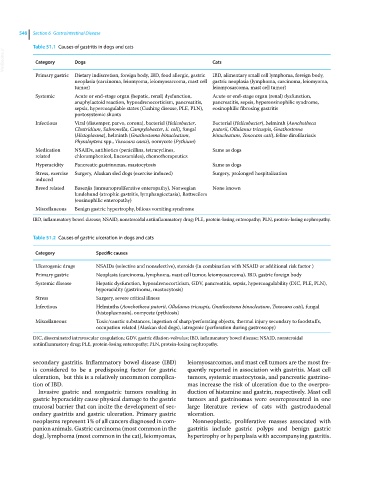Page 580 - Clinical Small Animal Internal Medicine
P. 580
548 Section 6 Gastrointestinal Disease
Table 51.1 Causes of gastritis in dogs and cats
VetBooks.ir Category Dogs Cats
Primary gastric Dietary indiscretion, foreign body, IBD, food allergic, gastric IBD, alimentary small cell lymphoma, foreign body,
neoplasia (carcinoma, leiomyoma, leiomyosarcoma, mast cell gastric neoplasia (lymphoma, carcinoma, leiomyoma,
tumor) leiomyosarcoma, mast cell tumor)
Systemic Acute or end-stage organ (hepatic, renal) dysfunction, Acute or end-stage organ (renal) dysfunction,
anaphylactoid reaction, hypoadrenocorticism, pancreatitis, pancreatitis, sepsis, hypereosinophilic syndrome,
sepsis, hypercoagulable states (Cushing disease, PLE, PLN), eosinophilic fibrosing gastritis
portosystemic shunts
Infectious Viral (distemper, parvo, corona), bacterial (Helicobacter, Bacterial (Helicobacter), helminth (Aonchotheca
Clostridium, Salmonella, Campylobacter, E. coli), fungal putorii, Ollulanus tricuspis, Gnathostoma
(Histoplasma), helminth (Gnathostoma binucleatum, binucleatum, Toxocara cati), feline dirofilariasis
Physaloptera spp., Toxocara canis), oomycete (Pythium)
Medication NSAIDs, antibiotics (penicillins, tetracyclines, Same as dogs
related chloramphenicol, lincosamides), chemotherapeutics
Hyperacidity Pancreatic gastrinomas, mastocytosis Same as dogs
Stress, exercise Surgery, Alaskan sled dogs (exercise induced) Surgery, prolonged hospitalization
induced
Breed related Basenjis (immunoproliferative enteropathy), Norwegian None known
lundehund (atrophic gastritis, lymphangiectasia), Rottweilers
(eosinophilic enteropathy)
Miscellaneous Benign gastric hypertrophy, bilious vomiting syndrome
IBD, inflammatory bowel disease; NSAID, nonsteroidal antiinflammatory drug; PLE, protein‐losing enteropathy; PLN, protein‐losing nephropathy.
Table 51.2 Causes of gastric ulceration in dogs and cats
Category Specific causes
Ulcerogenic drugs NSAIDs (selective and nonselective), steroids (in combination with NSAID or additional risk factor )
Primary gastric Neoplasia (carcinoma, lymphoma, mast cell tumor, leiomyosarcoma), IBD, gastric foreign body
Systemic disease Hepatic dysfunction, hypoadrenocorticism, GDV, pancreatitis, sepsis, hypercoagulability (DIC, PLE, PLN),
hyperacidity (gastrinoma, mastocytosis)
Stress Surgery, severe critical illness
Infectious Helminths (Aonchotheca putorii, Ollulanus tricuspis, Gnathostoma binucleatum, Toxocara cati), fungal
(histoplasmosis), oomycete (pythiosis)
Miscellaneous Toxic/caustic substances, ingestion of sharp/perforating objects, thermal injury secondary to foodstuffs,
occupation related (Alaskan sled dogs), iatrogenic (perforation during gastroscopy)
DIC, disseminated intravascular coagulation; GDV, gastric dilation‐volvulus; IBD, inflammatory bowel disease; NSAID, nonsteroidal
antiinflammatory drug; PLE, protein‐losing enteropathy; PLN, protein‐losing nephropathy.
secondary gastritis. Inflammatory bowel disease (IBD) leiomyosarcomas, and mast cell tumors are the most fre-
is considered to be a predisposing factor for gastric quently reported in association with gastritis. Mast cell
ulceration, but this is a relatively uncommon complica- tumors, systemic mastocytosis, and pancreatic gastrino-
tion of IBD. mas increase the risk of ulceration due to the overpro-
Invasive gastric and nongastric tumors resulting in duction of histamine and gastrin, respectively. Mast cell
gastric hyperacidity cause physical damage to the gastric tumors and gastrinomas were overrepresented in one
mucosal barrier that can incite the development of sec- large literature review of cats with gastroduodenal
ondary gastritis and gastric ulceration. Primary gastric ulceration.
neoplasms represent 1% of all cancers diagnosed in com- Nonneoplastic, proliferative masses associated with
panion animals. Gastric carcinoma (most common in the gastritis include gastric polyps and benign gastric
dog), lymphoma (most common in the cat), leiomyomas, hypertrophy or hyperplasia with accompanying gastritis.

